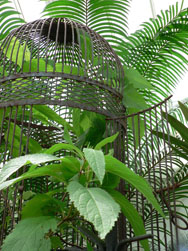Wanted for Murder
One of the most infamous offenders on view is the castor bean, a dramatic shrub with poisonous seeds, implicated in the 1978 'umbrella murder' of communist defector BBC journalist Georgi Markov. Waiting at a London bus stop, Markov felt a painful jab in the back of his thigh. He turned around in time to see a man pick up an umbrella as he fled. After three days of fever and throwing up blood, he died. The pathologist found hemorrhages in almost every organ of Markov’s body as well as a small tiny metal pellet in his leg. The pellet contained ricin, the poisonous extract of the castor bean seed. KGB agents were suspected of the crime, but no one was ever charged with the infamous murder.
White snakeroot, a tall weed found in the woods across eastern North America and throughout the South, took the life of Nancy Hanks Lincoln, mother of Abraham Lincoln. She and several other residents of the small town of Little Pigeon Creek, Indiana succumbed to milk sickness, a condition brought on by ingesting the milk of cattle that had grazed on the plant. Cattle and horses also died in droves. The 'disease' was so prevalent in early America that names like Milk Sick Ridge, Milk Sick Cove, and Milk Sick Holler are still attached to places in the South where it was rampant.
Poison hemlock, a plant in the carrot family, is so toxic that it is known in Scotland as 'deid men’s oatmeal Its most famous victim was Greek philosopher Socrates, who, after being convicted in 399 BC of corrupting the youth of Athens, among other offenses, was forced to drink it as his death sentence.
The Menace in Your Garden and Home
Apart from these famously shady plants are many that appear innocent but are anything but. Included in the exhibition are many of the houseplants and common garden plants around us that can deliver nasty surprises from rashes and irritation to sickness and death. Aconite, commonly known as monkshood (above) and found in gardens throughout Europe and the US, is so poisonous that Nazi scientists used it as an ingredient for poisonous bullets. The poison paralyzes the nerves, lowers the blood pressure, and then stops the heart. Even brushing against it can cause numbness, tingling, and cardiac symptoms.
Hellebore, (below) also known as Christmas rose, is a low growing perennial with dramatic foliage and beautiful blossoms that may well have been the key ingredient in the first case of chemical warfare in recorded history. Some historians believe it was used by a Greek military alliance to poison the water of the city of Kirrha in the first Sacred War (595-585 BC). Other garden-variety killers included in the exhibition include oleander, foxglove, larkspur, delphinium, sago palm and more.
Poison control centers in the United States got over 1600 calls in 2006 related to poisonings caused by a common houseplant native to South America — the philodendron. Eating a leaf could lead to severe abdominal pain, and repeated skin contact can cause serious allergic reactions. Peace lily, English ivy, ficus and more of these potentially harmful houseplants are also on display.
More Articles
- The Scout Report: Civil Rights Toolkit; Be All Write; Plants Are Cool, Too; NextStrain; Women'n Art; 500 Years of Women In British Art
- Elaine Soloway's Widow Series: The Opposite of Caregiving & The Takeover
- Serendipity in the Woods: Author Carol Gracie Explores the History and Life of Wildflowers
- A MoMA Look Back: The Delphiniums of Edward Steichen






